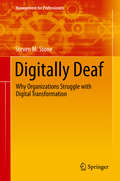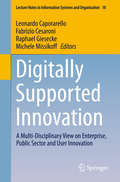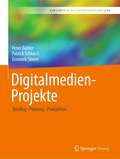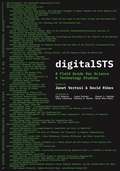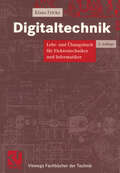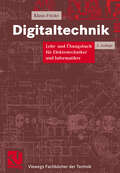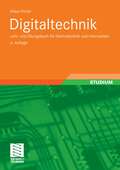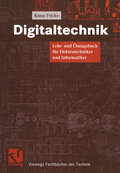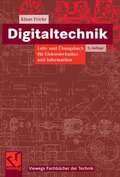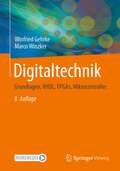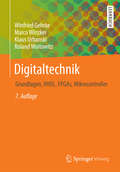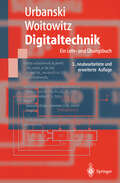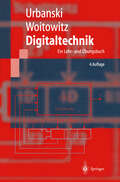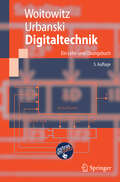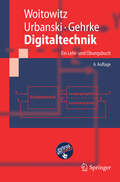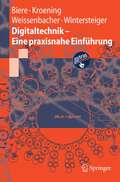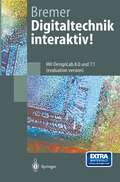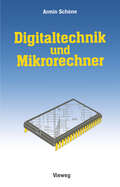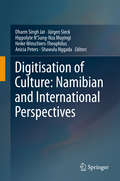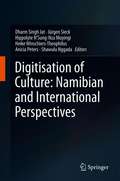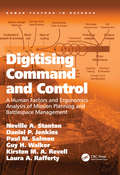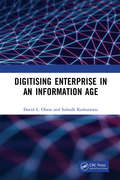- Table View
- List View
Digitally Deaf: Why Organizations Struggle with Digital Transformation (Management for Professionals)
by Steven M. StoneCompanies across all industries are leveraging digital technologies to transform outdated processes and build new business models to compete in the information age. For all the publicity and hype, successful digital transformation has proven to be elusive. Numerous studies have found more than half of all digital transformation efforts fail. Digitally Deaf explores the obstacles and inhibitors that derail transformation efforts and outlines the steps organizations should take to establish an environment for success. Written by a highly experienced CIO, Digitally Deaf illustrates symptoms and underlying issues through the author’s experiences at large, Fortune 250 organizations. Digitally Deaf establishes a framework for digital transformation execution beginning with the development of a common definition and language for transformation. Learn the roles of the board of directors and leadership in establishing the appropriate messaging, governance, and organizational structure to drive digital efforts. Realize how digital transformation efforts amplify common problems encountered in typical technology projects. Discover how the IT organization must transform to enable the agility needed to fuel new digital business models. Finally, learn to spot the symptoms of issues that undermine transformation success and how to address them.“On the topic of digital transformation, Steve addresses the mind set shift that is needed to be successful, leveraging relatable examples across multiple industries. Digitally Deaf offers a very relevant perspective on what it takes to move a traditional organization into the digital age.” Boris Sherman, CTO Tailored Brands “Stone, as a former CIO, accurately outlines the challenges associated with new technologies and the benefits of implementing a digital-first culture. This book helps business and technology leaders understand the landscape and how to embrace digital to create new sources of value in their organizations.” Jonathan Brassington, Head, Capgemini Invent North America
Digitally Supported Innovation: A Multi-Disciplinary View on Enterprise, Public Sector and User Innovation (Lecture Notes in Information Systems and Organisation #18)
by Leonardo Caporarello Fabrizio Cesaroni Raphael Giesecke Michele MissikoffThis book provides a broad overview of Information and Communication Technology (ICT)-supported innovation both on an evidence-based level, a theoretical and a methodological level. It presents multi-disciplinary perspectives on organizational innovation in enterprises and the public sector, and on the ubiquitous social media-based user innovations. The book especially highlights innovation in knowledge work and human-computer interaction, innovation of and in socio-technical systems, and user-based innovation in public services. It draws upon evidence from various areas of application, including innovative mobility and the factories of the future. The studies presented here will be helpful both for innovation scholars and practitioners in industry – as well as innovators at large – in their current and future studies and undertakings.
Digitalmedien-Projekte: Briefing – Planung – Produktion (Bibliothek der Mediengestaltung)
by Peter Bühler Patrick Schlaich Dominik SinnerDieser Band der „Bibliothek der Mediengestaltung“ behandelt die Konzeption und Produktion folgender Digitalmedien-Projekte: PräsentationInteraktiver ProspektAnimierte InfografikAnimationWebsite (Mockup)WebformularSingle-Page-WebsiteResponsive WebsiteInteraktive WebsiteDynamische WebsiteApp (Mockup) Die vier Projektebände dieser Buchreihe verfolgen das Ziel, einen Praxis- und Anwendungsbezug zu den eher theoretisch ausgerichteten 26 Einzelbänden der „Bibliothek der Mediengestaltung“ herzustellen. Jedes Kapitel ist identisch aufgebaut und gliedert sich in Briefing, Planung und Produktion des jeweiligen Projektes. Die Umsetzung der Projekte kann anhand von Schritt-für-Schritt-Anleitungen problemlos nachvollzogen werden. Sämtliche Dateien, die für das Projekt erforderlich sind, können auf bi-me.de heruntergeladen werden. Das Buch eignet sich sowohl zum Einsatz im Unterricht an Schulen und Hochschulen als auch zum Selbststudium, z. B. zur Vorbereitung auf Klausuren oder Prüfungen.
digitalSTS: A Field Guide for Science & Technology Studies
by Janet Vertesi David RibesScholars across the humanities, social sciences, and information sciences are grappling with how best to study virtual environments, use computational tools in their research, and engage audiences with their results. Classic work in science and technology studies (STS) has played a central role in how these fields analyze digital technologies, but many of its key examples do not speak to today’s computational realities. This groundbreaking collection brings together a world-class group of contributors to refresh the canon for contemporary digital scholarship.In twenty-five pioneering and incisive essays, this unique digital field guide offers innovative new approaches to digital scholarship, the design of digital tools and objects, and the deployment of critically grounded technologies for analysis and discovery. Contributors cover a broad range of topics, including software development, hackathons, digitized objects, diversity in the tech sector, and distributed scientific collaborations. They discuss methodological considerations of social networks and data analysis, design projects that can translate STS concepts into durable scientific work, and much more.Featuring a concise introduction by Janet Vertesi and David Ribes and accompanied by an interactive microsite, this book provides new perspectives on digital scholarship that will shape the agenda for tomorrow’s generation of STS researchers and practitioners.
digitalSTS: A Field Guide for Science & Technology Studies
by Janet Vertesi David RibesScholars across the humanities, social sciences, and information sciences are grappling with how best to study virtual environments, use computational tools in their research, and engage audiences with their results. Classic work in science and technology studies (STS) has played a central role in how these fields analyze digital technologies, but many of its key examples do not speak to today’s computational realities. This groundbreaking collection brings together a world-class group of contributors to refresh the canon for contemporary digital scholarship.In twenty-five pioneering and incisive essays, this unique digital field guide offers innovative new approaches to digital scholarship, the design of digital tools and objects, and the deployment of critically grounded technologies for analysis and discovery. Contributors cover a broad range of topics, including software development, hackathons, digitized objects, diversity in the tech sector, and distributed scientific collaborations. They discuss methodological considerations of social networks and data analysis, design projects that can translate STS concepts into durable scientific work, and much more.Featuring a concise introduction by Janet Vertesi and David Ribes and accompanied by an interactive microsite, this book provides new perspectives on digital scholarship that will shape the agenda for tomorrow’s generation of STS researchers and practitioners.
digitalSTS: A Field Guide for Science & Technology Studies
by Janet Vertesi David RibesScholars across the humanities, social sciences, and information sciences are grappling with how best to study virtual environments, use computational tools in their research, and engage audiences with their results. Classic work in science and technology studies (STS) has played a central role in how these fields analyze digital technologies, but many of its key examples do not speak to today’s computational realities. This groundbreaking collection brings together a world-class group of contributors to refresh the canon for contemporary digital scholarship.In twenty-five pioneering and incisive essays, this unique digital field guide offers innovative new approaches to digital scholarship, the design of digital tools and objects, and the deployment of critically grounded technologies for analysis and discovery. Contributors cover a broad range of topics, including software development, hackathons, digitized objects, diversity in the tech sector, and distributed scientific collaborations. They discuss methodological considerations of social networks and data analysis, design projects that can translate STS concepts into durable scientific work, and much more.Featuring a concise introduction by Janet Vertesi and David Ribes and accompanied by an interactive microsite, this book provides new perspectives on digital scholarship that will shape the agenda for tomorrow’s generation of STS researchers and practitioners.
Digitaltechnik: Lehr- und Übungsbuch für Elektrotechniker und Informatiker (Viewegs Fachbücher der Technik)
by Klaus FrickeHeutzutage sind Kenntnisse der Digitaltechnik für das Verständnis von vielen technischen Anwendungen unerlässlich. Das Buch gibt einen lückenlosen Überblick von den Grundlagen der Digitaltechnik bis hin zum Aufbau und der Programmierung einfacher Mikroprozessoren. Dabei wurde besonderer Wert auf eine ausführliche Darstellung der Grundlagen gelegt. Es werden keine Grundkenntnisse der Elektronik vorausgesetzt, sodass sich das Buch nicht nur an Ingenieure und Studenten, sondern auch an den interessierten Laien richtet. Für die 3. Auflage wurden neben kleineren Korrekturen und Aktualisierungen zu jedem Kapitel weitere Übungsaufgaben hinzugefügt. Auch die Lösungsvorschläge im Anhang wurden entsprechend ergänzt.
Digitaltechnik: Lehr- und Übungsbuch für Elektrotechniker und Informatiker (Viewegs Fachbücher der Technik)
by Klaus FrickeHeutzutage sind Kenntnisse der Digitaltechnik für das Verständnis von vielen technischen Anwendungen unerlässlich. Das Buch gibt einen lückenlosen Überblick von den Grundlagen der Digitaltechnik bis hin zum Aufbau und der Programmierung einfacher Mikroprozessoren. Dabei wurde besonderer Wert auf eine ausführliche Darstellung der Grundlagen gelegt. Es werden keine Grundkenntnisse der Elektronik vorausgesetzt, sodass sich das Buch nicht nur an Ingenieure und Studenten, sondern auch an den interessierten Laien richtet.
Digitaltechnik: Lehr- und Übungsbuch für Elektrotechniker und Informatiker
by Klaus FrickeDieses Lehr- und Übungsbuch stellt praxisnah und lückenlos die Grundlagen der Digitaltechnik bis hin zur Programmierung einfacher Mikroprozessoren dar. Die Darstellung der booleschen Algebra und die verwendeten Symbole entsprechen der geltenden DIN-Norm. Die Kapitel über synchrone und asynchrone Schaltwerke wurden überarbeitet und übersichtlicher gegliedert. Übungsaufgaben am Ende eines jeden Kapitels und deren Lösung im Anhang ermöglichen auch in dieser 6. Auflage ein erfolgreiches Selbststudium.
Digitaltechnik: Lehr- und Übungsbuch für Elektrotechniker und Informatiker (Viewegs Fachbücher der Technik)
by Klaus Fricke-NeuderthIn diesem Buch werden die Grundlagen der Digitaltechnik behandelt, wie sie im technischen Studium an Hoch- und Fachhochschulen vermittelt werden. Es stellt die Basis für das Verständnis über die Funktion von Schaltnetzen, Schaltwerken und einfachen Mikroprozessoren dar.
Digitaltechnik: Lehr- und Übungsbuch für Elektrotechniker und Informatiker (Viewegs Fachbücher der Technik)
by Klaus Fricke-NeuderthDieses Lehr- und Übungsbuch stellt praxisnah und lückenlos die Grundlagen der Digitaltechnik bis hin zur Programmierung einfacher Mikroprozessoren dar. Die Darstellung der booleschen Algebra und die verwendeten Symbole entsprechen der geltenden DIN-Norm. Die bewährte Einführung in VHDL, sowie die ausführliche Behandlung des weit verbreiteten Mikrocontrollers 68HC11 ermöglichen auch in dieser 5. Auflage mit weiteren Übungsaufgaben am Ende eines jeden Kapitels und deren Lösung im Anhang ein erfolgreiches Selbststudium. Im Kapitel Synchrone Schaltwerke sind neue Beispiele eingefügt und vorhandene erweitert. In weiteren Kapiteln werden die Inhalte Digitale Speicher und Programmierbare Logikbausteine aktualisiert und überarbeitet, insbesondere die Themen FPGA und CPLD durch die Verwendung neuester Bauelemente als Beispiele.
Digitaltechnik: Grundlagen, VHDL, FPGAs, Mikrocontroller
by Winfried Gehrke Marco WinzkerModerne Digitaltechnik, umfassend und kompakt: Dieses Lehr- und Übungsbuch spannt den Bogen von den Grundlagen der Digitaltechnik über den Entwurf mit VHDL und Komponenten digitaler Systeme bis zu modernen Mikrocontrollern der STM32-Serie.Digitale Grundelemente wie Logikgatter und Flip-FlopsKombinatorische und sequenzielle SchaltungenSchaltungsentwurf und Simulation mit VHDLProgrammierbare Logikbausteine: CPLDs, FPGAsHalbleiterspeicherA/D- und D/A-UmsetzerArchitektur von MikroprozessorenProgrammierung von Arm® CortexTM Mikroprozessoren in C und Assembler32-Bit-Mikrocontroller der STM32-FamilieFunktion und Programmierung von STM32-Peripheriemodulen Die 8. Auflage wurde aktualisiert und die Themenbereiche Mikroprozessoren und Mikrocontroller grundlegend überarbeitet.Zahlreiche Beispiele erleichtern das Verständnis. Viele Übungsaufgaben mit Musterlösungen unterstützen die Lernkontrolle und stehen zu jedem Kapitel zur Verfügung. Ergänzendes Material wird auf der Webseite zum Buch angeboten.Das Buch ist so konzipiert, dass es sowohl als Begleitlektüre von Lehrveranstaltungen als auch für das Selbststudium in den Bereichen Digitaltechnik, Mikrocontroller und Systementwurf geeignet ist.
Digitaltechnik: Grundlagen, VHDL, FPGAs, Mikrocontroller (Springer-Lehrbuch)
by Winfried Gehrke Marco Winzker Klaus Urbanski Roland WoitowitzDas Buch spannt den Bogen von den Grundlagen der Digitaltechnik über den Entwurf mit VHDL zu den wichtigsten Komponenten digitaler Systeme. Die 7. Auflage wurde grundlegend überarbeitet und aktualisiert. Folgende Themen werden diskutiert:• Digitale Grundelemente wie Logikgatter und Flip-Flops • Kombinatorische und sequentielle Schaltungen• Schaltungsentwurf und Simulation mit VHDL• Programmierbare Logikbausteine (CPLDs, FPGAs)• Halbleiterspeicher• AD-/DA-Umsetzer• Architektur von Mikroprozessoren• MikrocontrollerZahlreiche Beispiele erleichtern das Verständnis. Übungsaufgaben mit Musterlösungen unterstützen die Lernkontrolle und stehen zu jedem Kapitel zur Verfügung.
Digitaltechnik: Ein Lehr- und Übungsbuch (Springer-Lehrbuch)
by K. Urbanski R. WoitowitzDas Buch führt verständlich in die Grundlagen der modernen Digitaltechnik ein. Neben den grundlegenden Logikbausteinen und programmierbaren Bausteinen wird die Mikroprozessor- und Mikrocontroller-Technik behandelt. Einen Schwerpunkt bildet der systematische Entwurf von Schaltnetzen und Schaltwerken unter Einsatz von programmierbarer Bausteinen. Mit Beispielen sowie Übungen und Lösungen zu jedem Kapitel.
Digitaltechnik: Ein Lehr- und Übungsbuch (Springer-Lehrbuch)
by Klaus Urbanski Roland WoitowitzVerständliche, moderne Einführung jetzt in 5., aktualisierter Auflage: Die Autoren verwenden zahlreiche Beispiele und Übungen mit ausführlichen Lösungen. Die Website bietet zusätzliche Übungen, Beiblätter, VHDL-Modelle, Assembler- und C-Programme zum Download.
Digitaltechnik: Ein Lehr- und Übungsbuch (Springer-Lehrbuch)
by Roland Woitowitz Klaus UrbanskiVerständliche, moderne Einführung: Die Autoren erläutern Logik- und programmierbare Bausteine, die Mikroprozessor- und Mikrocontroller-Technik sowie den systematischen Entwurf von Schaltnetzen und -werken unter Einsatz programmierbarer Bausteine. Zahlreiche Beispiele erleichtern das Verständnis. Alle normgerecht angepassten Kapitel bieten Übungen mit ausführlichen Lösungen. Daher eignet sich das Buch auch besonders zum Selbststudium. Neu in der 5. Auflage: Quad Datarate SDRAM, die neuen binären Vorsätze für Zweierpotenzen. Plus: Website mit zusätzlichen Übungen, Beiblättern, VHDL-Modellen, Assembler- und C-Programmen zum Download.
Digitaltechnik: Ein Lehr- und Übungsbuch (Springer-Lehrbuch)
by Roland Woitowitz Klaus Urbanski Winfried GehrkeDas Buch bietet eine verständliche Einführung in die Grundlagen der modernen Digitaltechnik. Um Anfängern den Einstieg zu erleichtern, führen die Autoren von Beginn an die Hardwarebeschreibungssprache VHDL ein. Ein Schwerpunkt der Darstellung ist der systematische Entwurf kombinatorischer und sequenzieller Schaltungen mit VHDL unter Einsatz programmierbarer Logik und bereichert durch Simulationstechniken. Zu allen Kapiteln werden Übungsaufgaben mit Musterlösungen angeboten, daher eignet sich das Lehrbuch auch für das Selbststudium.
Digitaltechnik - Eine praxisnahe Einführung
by Armin Biere Daniel Kröning Georg Weissenbacher Christoph M. WintersteigerSpeziell für Bachelor-Studenten entwickelt, enthält das Lehrbuch viele praktische Anwendungen, die auf Anfänger zugeschnitten sind. Als einziges einführendes Werk in diesem Bereich werden auch nur sehr geringe mathematische Kenntnisse vorausgesetzt. Die Anwendungen stützen sich auf Tools wie XILINX ISE und MentorGraphics ModelSim, die in der Industrie eingesetzt werden. Anstelle des veralteten VHDL wird die Hardwarebeschreibungssprache Verilog verwendet. Eine Internet-Plattform bietet weitere Übungen und Beispiele sowie Folien für Dozenten.
Digitaltechnik interaktiv!: Mit DesignLab 8.0 und 7.1 (evaluation version) (Springer-Lehrbuch)
by Hans-Georg BremerMit dem vorliegenden Werk stellt der Autor die Grundlagen der Digitaltechnik für Studenten der Informatik und der Elektrotechnik verständlich dar. Ausgehend von den Grundschaltungen kann sich der Nutzer die verschiedenen Schaltungen und Rechenwerke interaktiv erarbeiten. Der exemplarische Aufbau und die Funktionsweise eines Mikrocomputers, Fuzzy-Logik-Programmierung und die Handhabung von Simulationsprogrammen runden das Werk ab. Das Handbuch führt sicher durch das multimediale Programm und erleichtert die interaktive Arbeitsweise in Verbindung mit der Evaluation-Software DesignLab. Dadurch kann der Lernende sein gewonnenes Wissen unmittelbar an simulierten praktischen Schaltungen überprüfen.
Digitisation of Culture: Namibian and International Perspectives
by Dharm Singh Jat Jürgen Sieck Hippolyte N'Sung-Nza Muyingi Heike Winschiers-Theophilus Anicia Peters Shawulu NggadaThis book explores the digitization of culture as a means of experiencing and understanding cultural heritage in Namibia and from international perspectives. It provides various views and perspectives on the digitization of culture, the goal being to stimulate further research, and to rapidly disseminate related discoveries. Aspects covered here include: virtual and augmented reality, audio and video technology, art, multimedia and digital media integration, cross-media technologies, modeling, visualization and interaction as a means of experiencing and grasping cultural heritage. Over the past few decades, digitization has profoundly changed our cultural experience, not only in terms of digital technology-based access, production and dissemination, but also in terms of participation and creation, and learning and partaking in a knowledge society. Computing researchers have developed a wealth of new digital systems for preserving, sharing and interacting with cultural resources. The book provides important information and tools for policy makers, knowledge experts, cultural and creative industries, communication scientists, professionals, educators, librarians and artists, as well as computing scientists and engineers conducting research on cultural topics.
Digitisation Of Culture: Namibian And International Perspectives (PDF)
by Dharm Singh Jat Jürgen Sieck Hipollyte Muyingi Heike Winschiers-Theophilus Anicia Peters Shawulu Nggada Hippolyte N'Sung-Nza MuyingiThis book explores the digitization of culture as a means of experiencing and understanding cultural heritage in Namibia and from international perspectives. It provides various views and perspectives on the digitization of culture, the goal being to stimulate further research, and to rapidly disseminate related discoveries. Aspects covered here include: virtual and augmented reality, audio and video technology, art, multimedia and digital media integration, cross-media technologies, modeling, visualization and interaction as a means of experiencing and grasping cultural heritage. Over the past few decades, digitization has profoundly changed our cultural experience, not only in terms of digital technology-based access, production and dissemination, but also in terms of participation and creation, and learning and partaking in a knowledge society. Computing researchers have developed a wealth of new digital systems for preserving, sharing and interacting with cultural resources. The book provides important information and tools for policy makers, knowledge experts, cultural and creative industries, communication scientists, professionals, educators, librarians and artists, as well as computing scientists and engineers conducting research on cultural topics.
Digitising Command and Control: A Human Factors and Ergonomics Analysis of Mission Planning and Battlespace Management (Human Factors in Defence)
by Neville A. Stanton Daniel P. Jenkins Paul M. Salmon Guy H. Walker Kirsten M. Revell Laura A. RaffertyThis book presents a human factors and ergonomics evaluation of a digital Mission Planning and Battle-space Management (MP/BM) system. An emphasis was placed on the activities at the Brigade (Bde) and the Battle Group (BG) headquarters (HQ) levels. The analysts distributed their time evenly between these two locations. The human factors team from Brunel University, as part of the HFI DTC, undertook a multi-faceted approach to the investigation, including: - observation of people using the traditional analogue MP/BM processes in the course of their work - cognitive work analysis of the digital MP/BM system - analysis of the tasks and goal structure required by the digital MP/BM - assessment against a usability questionnaire - analysis of the distributed situation awareness - an environmental survey. The book concludes with a summary of the research project's findings and offers many valuable insights. For example, the recommendations for short-term improvements in the current generation of digital MP/BM system address general design improvements, user-interface design improvements, hardware improvements, infrastructure improvements and support improvements. In looking forward to the next generation digital MP/BM systems, general human factors design principles are presented and human factors issues in digitising mission planning are considered.
Digitising Command and Control: A Human Factors and Ergonomics Analysis of Mission Planning and Battlespace Management (Human Factors in Defence)
by Neville A. Stanton Daniel P. Jenkins Paul M. Salmon Guy H. Walker Kirsten M. Revell Laura A. RaffertyThis book presents a human factors and ergonomics evaluation of a digital Mission Planning and Battle-space Management (MP/BM) system. An emphasis was placed on the activities at the Brigade (Bde) and the Battle Group (BG) headquarters (HQ) levels. The analysts distributed their time evenly between these two locations. The human factors team from Brunel University, as part of the HFI DTC, undertook a multi-faceted approach to the investigation, including: - observation of people using the traditional analogue MP/BM processes in the course of their work - cognitive work analysis of the digital MP/BM system - analysis of the tasks and goal structure required by the digital MP/BM - assessment against a usability questionnaire - analysis of the distributed situation awareness - an environmental survey. The book concludes with a summary of the research project's findings and offers many valuable insights. For example, the recommendations for short-term improvements in the current generation of digital MP/BM system address general design improvements, user-interface design improvements, hardware improvements, infrastructure improvements and support improvements. In looking forward to the next generation digital MP/BM systems, general human factors design principles are presented and human factors issues in digitising mission planning are considered.
Digitising Enterprise in an Information Age
by David L. Olson Subodh KesharwaniDigitising Enterprise in an Information Age is an effort that focuses on a very vast cluster of Enterprises and their digitising technology involvement and take us through the road map of the implementation process in them, some of them being ICT, Banking, Stock Markets, Textile Industry & ICT, Social Media, Software Quality Assurance, Information Systems Security and Risk Management, Employee Resource Planning etc. It delves on increased instances of cyber spamming and the threat that poses to e-Commerce and Banking and tools that help and Enterprise toward of such threats. To quote Confucius, “As the water shapes itself to the vessel that contains it, so does a wise man adapts himself to circumstances.” And the journey of evolution and progression will continue and institutions and enterprises will continue to become smarter and more and more technology savvy. Enterprises and businesses across all genre and spectrum are trying their level best to adopt to change and move on with the changing requirements of technology and as enterprises and companies upgrade and speed up their digital transformations and move their outdate heirloom systems to the cloud, archaic partners that don't keep up will be left behind. Note: T&F does not sell or distribute the Hardback in India, Pakistan, Nepal, Bhutan, Bangladesh and Sri Lanka.
